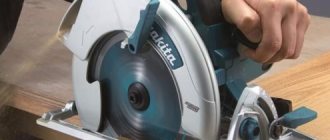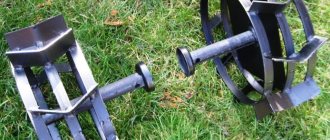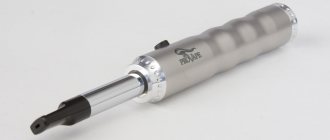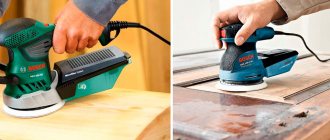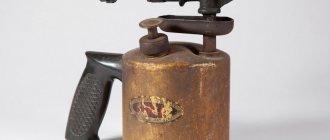Even in conditions of widespread Bulgarians and other types of metal-cutting hand tools traditional hacksaws for metal have not sunk into oblivion. Sometimes it is much easier, faster and safer to cut metal manually, using an ordinary saw blade.
The main difference between saws for metal and wood is the height of the teeth. In hacksaws for cutting metal, the teeth have a height of 1-1.5 (mm). For cutting wood, higher teeth are used, from 2 to 5-7 (mm) and even more.
A hacksaw is a saw designed for cutting metal workpieces. This tool consists of a frame and a saw blade. Unlike the vast majority of saws for wood, in saws for metal the blade is rigidly attached. The only exceptions are hand saws for metal with one-sided fastening.
Of course, today the position of hacksaws for metal has been greatly replaced by grinders and band saws . When performing voluminous work, that is, cutting a large number of workpieces, it makes sense to use the same grinder. When you need to make only 1-3 cuts, then very often craftsmen give preference to a hand hacksaw for metal .
Let's talk about the types of hacksaws for metal.
Characteristics and purpose
The main purpose of a hacksaw is to cut various materials. The main one is metal, but since there are many small teeth on the blade, it can be used to separate:
- plastic;
- ceramics;
- polyvinyl chloride;
- Styrofoam;
- particle boards;
- laminate;
- plexiglass;
- tree.
When choosing a hand tool, you need to pay attention to the blade. Blades are manufactured according to the requirements of GOST R 53411-2009. This document describes the standards by which hacksaw blades are divided into three groups, differing in size:
- Double. The distance between the holes for fastening into clamps is 300 mm (permissible error 2 mm). Blade length - 315 mm. The height of the teeth is 20 mm. Thickness - 0.8 mm.
- Single. The distance between the mounting holes is 300 mm. The permissible error is 2 mm. Total length - 315 mm.
- Single shortened. The distance between the mounting holes is 250 mm. Total length - 265 mm.
The height of single panels is 12.5 mm, thickness is 0.63 mm.
Plexiglas in packaging (Photo: Instagram / rezka_stekla_soln)
How to choose a hacksaw for wood
There are quite a few options on the market that you can purchase. But some of them are in demand, while others have been in stock in specialized stores for a long time. It’s worth figuring out what you need to pay attention to when choosing.
Table. What to look for before buying a hacksaw
| Selection option | Short description |
| Length and size of the canvas | It is recommended to choose saws with a blade larger than 250 mm because they will be able to handle most workpieces. The optimal size is 450 mm. It is required that the thickness of the workpiece be at least a pitch of three teeth, otherwise the work will not work. When the blade is significantly longer than the workpiece itself, the former begins to spring back. Then, under mechanical stress, it can bend and, in some cases, break. |
| Tooth size and shape | The teeth can be from 2 to 6 mm. The smaller they are, the more accurate the cut. Thus, for rough work, large teeth can be used to quickly cut wood. It is impossible to sharpen hardened teeth, but they have a very long service life. If there is no hardening, then it is possible to sharpen it yourself or in specialized companies. But professionals do not buy hacksaws with unhardened teeth. |
| Type of cutters |
|
| Hacksaw design |
|
The tool must be convenient
Important . These are just the basic parameters. But we must not forget about the price and type of handle. If you have to work for a long time, it is better to buy a tool with an anatomical and rubberized handle. then the hand will get less tired, the rubberized base will be able to absorb vibration.
Thus, if you buy a hacksaw from the list above, you can be sure of the quality. This tool meets all the requirements and can be used in most cases. At the same time, it is suitable, as a rule, for beginners and professionals. Literally a couple of models from the rating are not recommended for professional use, as mentioned in the product description.
Tooth geometry
There are four types of teeth on a hacksaw:
- wavy - used for straight cutting,
- inclined ones are used for the most precise cutting,
- large ones are distinguished by very fast and smooth operation. However, the disadvantage of this type of teeth is that they can leave a rough cut, that is, a mark on the material;
- fine with open sharpening - provides fast rough cutting.
Design
The hacksaw consists of several parts:
- Blades for hacksaws for metal. This is a removable item. It is used to cut workpieces made of different materials. It is a metal strip on which wedge-shaped teeth are located.
- Machine or frame. It is an arc that is made of different metals and alloys. The frame is needed to secure the canvas. It can be standard cast or sliding.
- Handles. It can be located in different places.
Modern hand tools can be equipped with additional mechanisms to increase comfort during work and expand functionality.
Hacksaw blades (Photo: Instagram / enerteh.by)
Design parameters of hand hacksaws for metal
A manual hacksaw looks quite simple:
- “U” shaped base or frame, predominantly made of metal
- Handle of different shapes for hand work
- A metal blade for a hand saw or a cutting element fixed at the edges of the frame
These are the main elements that make up hand hacksaws for metal. An important detail is the canvas, which has a characteristic appearance of teeth. Fine teeth are designed specifically for working with hard materials.
to the frame . Alloy steel is used to make the frame. Frames come in different types, shapes and designs. Professional hand-held devices have the function of adjusting the angle of inclination of the blades. There are frame options that can slide apart. This feature in the tool allows you to install cutting elements of different lengths.
The handle is also an important component, as it can provide convenience and comfort in using the tool. Handles come in different shapes and are also made from materials such as wood, metal, plastic. The simplest handle is made of wood, and the most comfortable devices are considered to have a two-component composition: metal and a rubber insert.
A blade for a hand hacksaw for metal is a thin strip that is made from hard types of steel and has different lengths. There are wedge-shaped teeth on one or both sides. The hacksaw blade is the most fragile element of the tool, so when working it is important to control the rigidity of its fastening. Cutting elements for hand saws are made using the method of heat treatment of teeth, which allows you to extend the service life of the product.
It is important to pay attention! The blade for a hand saw is not intended for sharpening, so when the teeth wear out, it must be replaced. Today, blades made of bimetal and hardened metal (nickel-plated stainless steel) are produced. They differ in color: the bimetallic sheet is painted in different colors, and the completely hardened one has a dark color.
When choosing a canvas, attention is paid to its length. The length of the blade can be from 10 cm to 70 cm. A classic manual mechanical hacksaw allows you to use blades 30 cm long, since these are the dimensions of the tool that are the most comfortable and convenient for work.
Types of hacksaws
Varieties:
- Household. Standard hand tools for occasional household tasks. The handle is made of wood, and an adjustment screw is installed on the front of the frame.
- Hand saws. A compact tool designed for sawing metal in hard-to-reach places. Suitable for securing broken saw blades.
- Professional models. Their main difference is the high quality of materials from which the main parts of the structure are made.
You also need to pay attention to the division of hacksaws by drive type. They are electric and manual. Electric ones are divided into battery and network. The former allow you to work without connecting to the mains, which makes them more versatile, but the batteries gradually discharge and require charging, which reduces the time you use the power tool. Battery models are equipped with special systems to suppress vibrations.
Household hacksaw (Photo: Instagram / ploskogubtsy.ru)
Types and areas of application of the tool
The main purpose of a hacksaw is to cut metal products, cut seams, grooves, trim workpieces along outlined contours, etc. In addition, a hacksaw allows you to cut not only metal, but also, for example, foam plastic, ceramic products, plastic, organic glass and even wood.
In general, hacksaws for metal are divided into three types:
- home models are the most common and affordable option, which is optimal for performing simple tasks around the house and is particularly comfortable to use. Often, such hacksaws are equipped with additional tension screw mechanisms, combined with a wooden handle located longitudinally to the blade;
- professional hacksaws - suitable for longer work and obtaining precise cuts. Hacksaws of this level are equipped with a comfortable rubberized handle and make it possible to install the blades at an angle to make non-standard cuts;
- hacksaw-handle - has a special shape in the form of a bracket for working in hard-to-reach places. The equipment in such hacksaws is cantilevered and secured on only one side. The design of the hacksaw handles allows you to install even broken saw blades and is perfect for internal cuts.
Types of hacksaw blades
The hacksaw blade is considered the main part of the hand tool. The performance of the tool and the cutting accuracy depend on its type.
Metal cloth
It has a large number of small teeth. Large teeth will not cut metal.
Blade length - 150–300 mm. The canvas can be made from different materials:
- carbon steel;
- cobalt steel;
- carbon and high-speed steel.
Tungsten filament
Strings are made from tungsten carbide. Their length is 30 cm. They are suitable for fastening within standard hacksaws. String diameter - 2.7 mm. With its help you can make precise cuts. The string is suitable for straight and curved cuts, cutting out circles.
Diamond string
The basis of such a string is alloy steel, onto which diamond coating is applied. Coating thickness - 2 mm. The string is secured in the clamps using rings.
A high-quality diamond wire should quickly cut through various materials. When working, its surfaces and working area must be moistened with water to avoid overheating.
It is better to choose an arc with a handle and attach a diamond string to it. Such a hacksaw is cheaper than a professional hand tool, but it can be used to cut metal, concrete, stone, ceramics, etc.
Diamond string (Photo: Instagram / abraziv_ykt)
Tool selection criteria
Do not forget that you should select a hacksaw for metal in accordance with the recommendations, since mistakes made can lead to the purchase of a low-quality product. Even minor defects reduce the service life. The main criteria for choosing a tool for metal are the following points:
- The tooth shape is selected depending on the inclination of the cutting edge piece. In most cases, a classic form is created during production, since it is a universal option.
- Let's call the pitch of the teeth a rather important parameter. Too much will reduce productivity and improve cut quality. Many manufacturers indicate this parameter as one of the main ones; the indicator can vary over a very wide range.
- The length of the blade is selected depending on the size of the workpiece, as well as the metal tool itself. This figure varies from 300 to 700 mm. At the time of selection, care should be taken to ensure that there are no significant defects on the surface. Even after slight bending, the product should restore its shape.
- The handle is available in a variety of designs. Experts do not recommend giving preference to products with a hollow handle, as it can quickly break. At the time of selection, it is recommended to take the product in your hands; it should be comfortable. The handle has recently been made from two materials; the combination ensures a long service life. Corrugation on the surface reduces the likelihood of slipping during operation.
- The type of material used in the manufacture of the main part. An alloy characterized by increased resistance to moisture is most often used. Due to this, the service life is significantly increased.
- The fabric can be tensioned in a variety of ways. The ease of use of the device, as well as the service life of the blade used, largely depends on the features of the mechanism used.
- When choosing, attention is also paid to functionality. As previously noted, some mechanisms allow you to tilt the blade or change the length of the cutting part.
The most important selection criterion is cost. It is not recommended to give preference to budget options, as they will not last for a long period.
In conclusion, we note that a hacksaw is a basic tool. Even after the appearance of the grinder, it is very popular, as it can last for a long period and allows you to process hard-to-reach places. It is recommended to give preference to products from well-known brands, as they will last for a long period.
Selection principles
When purchasing a hacksaw for metal, you need to consider a number of criteria. It is important to study the strengths and weaknesses of the instrument and understand the manufacturers.
Criteria
Criterias of choice:
- The material from which the handle is made. Comfort when working with a hacksaw will depend on this. It is better to choose handles with rubber pads.
- The shape of the teeth, their size. They should not be large in order to cut metal without problems.
- Canvas size. Depends on the length of the workpieces being cut.
It is better to put aside a tool with a hollow handle, since it will break if pressed hard.
Mini hacksaw for metal (Photo: Instagram / wedotools)
Advantages
Positive sides:
- simplicity of design and maintenance;
- light weight;
- performing work in any conditions;
- reliability, durability;
- possibility of sharpening;
- application for sawing various materials;
- ease of use.
Manufacturers and prices
Manufacturers:
- "Enkor"
- Stanley;
- STAYER;
- GROSS;
- Top Tools.
The average price is 500 rubles.
Assortment of hacksaws (Photo: Instagram / stroi_it)
Why do you need hand hacksaws for metal?
Hand hacksaws for metal are intended for sawing metal materials. This is not the only purpose of the tool, as it has proven itself well in relation to materials such as plastic, chipboard, polystyrene foam, polystyrene foam, plexiglass, ceramics, laminate.
The saw in question for sawing metal is a very necessary tool in the household, because in the absence of a grinder, it can always help in the current situation - sawing off the head of an oxidized bolt or sawing through a steel wire. The big disadvantage of such a tool is the large expenditure of physical strength and time. The presence of small teeth affects the time to achieve results. To obtain results, the master requires the application of not only titanic strength, but also patience. The result of long and hard work with the tool is the most accurate result, which is sometimes superior to cutting with a grinder.
It is important to pay attention! The cutting line with a hand hacksaw for metal is as thin as possible, which is due to the presence of small teeth in the design of the blades.
Operating principles
To make cutting metal with a hacksaw more effective, when working with hand tools you must adhere to some rules:
- You need to hold the tool with both hands so that the blade does not bend. It is better to secure the workpieces in a vice.
- The ease of use of the tool can be increased by changing the cutting angle.
- The pressure must be increased when moving forward, and decreased when moving backward.
- It is important to practice in advance in securing the canvas in the clamps. It is important that it does not move when sawing.
Before you start working with a hacksaw, you need to check the sharpness and integrity of the teeth, their location relative to each other. If there are irregularities, the teeth move in different directions, the blade needs to be replaced.
Cutting a metal pipe (Photo: Instagram / ekb_tools)
How to properly saw with a hand hacksaw for metal
A hand saw for metal requires the craftsman to comply with the following operating rules:
- Adopting the correct stance for the master. Your feet should rest well on the floor, and work with the device is performed exclusively with two hands, so initially make sure that the workpiece is securely fastened in the vise jaws
- Reliable fixation of the canvas. Hacksaw blades are very fragile, so if the product “fidgets” from side to side if it is poorly secured, then at one point it will simply break
- Correct saw movements. To cut a part, you need not only to hold the tool correctly, but also to work with it. The tool is pressed against the part being cut when moving forward, and when returning to the reverse position, the clamping pressure is weakened. If you do not reduce the clamping pressure when moving the tool back, the teeth of the blade will quickly become dull
It is important to pay attention! The blade on the frame of a hand hacksaw for metal should be fixed in position with the teeth directed in the opposite direction from the handle.
Manufacturing
Any person without practical skills can make a homemade metal hacksaw. It is important to study in advance the structure of hand tools and how to connect the main parts.
A handle with an arc can be made from large-diameter wire, fittings, metal strips, profiled or plastic pipes. All that remains is to think about fastening the canvas.
A hacksaw is a hand-held tool for sawing workpieces made of different materials. To create high-quality cuts, you need to learn how to choose blades. We must not forget about the rules for choosing a frame with a handle. It is important that the tool is comfortable to work with and that the blades are securely held in the clamps.
Design features
The tool has a fairly simple design. Manual models resemble a bracket, between the ends of which a stretched fabric is fixed. The tool includes a frame and a blade with teeth.
Each of the elements of the tool has its own features and characteristics:
- The handle is very important in the process of work. This concerns convenience during long-term use. The best options for handles are two-component ones, equipped with special inserts made of soft but durable rubber. The handle is located on the top or side of the hacksaw.
- Frame securing the saw blade. It can be made from different materials. For cutting hard products, a frame made of high-strength composites is used. The design of this element is directly dependent on the conditions of its use. So, if you regularly have to saw metal in hard-to-reach places, it is better to purchase a device with adjustable inclination of the cutting blades or a small frame.
- The blade is a thin steel strip. This is the thinnest and most fragile element of the instrument. Therefore, during the work process you need to be as careful and careful as possible with fasteners. Sloppiness will lead to breakage of the canvas. This part contains wedge-shaped incisors (teeth). When choosing a saw, you should pay attention to whether the teeth of the cutting blade have been hardened, which allows you to increase the service life and performance of the tool. For cutting hard metal products, blades with small teeth are used, while soft structures are processed with large cutters. It is recommended to take bimetallic or hardened options. The blades are installed in the frame so that the teeth are in the opposite direction from the handle.
GOST sheets for metal
GOST 6645-86 is a state standard that sets requirements for the type, size, quality of metal blades, etc.
This document establishes the rules for the technical production of this product. In particular, this GOST specifies the grades of steel from which the types of blades must be made. For example, type 1 must be made from steel strip that meets all the requirements of GOST 23522-79. Type 2 hacksaw blade must be made of high-speed steel, which is determined according to GOST 19265-73. The document also states that the canvas must be subjected to heat treatment. A canvas is considered acceptable when there are no cracks, film, scale or corrosion on the surface.


